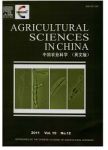Comparative Analysis of Six Triticum turgidum L. Subspecies for Acid and Aluminum Tolerance
Comparative Analysis of Six Triticum turgidum L. Subspecies for Acid and Aluminum Tolerance作者机构:Triticeae Research Institute Sichuan Agricultural University Chengdu 611130 P.R.China
出 版 物:《Agricultural Sciences in China》 (中国农业科学(英文版))
年 卷 期:2010年第9卷第5期
页 面:642-650页
核心收录:
学科分类:0710[理学-生物学] 071001[理学-植物学] 07[理学] 09[农学] 0901[农学-作物学]
基 金:supported by the China New Centary Excellent Talents in University (NCET-06-0819) the National Natural Science Foundation of China(30671272) the Foundation for Author of National Excellent Doctoral Dissertation of China (200458) the project of Sichuan Provincial Education Department and the Youth foundation of Sichuan Province, China(09ZQ026-088)
主 题:Triticum turgidum A1 tolerance acid tolerance
摘 要:The aluminum (A1) tolerance of hexaploid wheat and rye has been extensively studied. However, the A1 tolerance of tetraploid wheat (Triticum turgidum L.), the AABB genome donor of hexaploid wheat, has not been well characterized. To understand the A1 tolerance of tetraploid wheat and identify potentially new sources of tolerance to acidic soils, 254 Triticum turgidum wheat lines, including six subspecies of T. turdigum ssp. dieoccoides, ssp. dicoccon, ssp. carthlicum, ssp. turgidum, ssp. durum, and ssp. polinicum, were screened for acid and A1 tolerance by measuring the root regenerate lengths and the tolerance indices in acid nutrient culture solution containing A1. Significant differences were observed either among or within tetraploid wheat subspecies on the RRL (root regenerate lengths). The orders for average RRL among subspecies in pH 7.00, pH 4.50 and pH 4.50 + 50μmol L^-1 A1^3+ were carthlicum ≥ turgidum ≥ durum ≥ dicoccoides polinicum ≥ dicoccon, carthlicum ≥ turgidum ≥ durum ≥ polinicum ≥ dicoccon ≥ dicoccoides and durum ≥ dicoccoides carthlicum ≥ turgidum ≥polinicum ≥ dicoccon, respectively. Significant difference was also observed on the root acid tolerance index (RT11) and root A1 tolerance index (RTI2) either among or within tetraploid wheat subspecies. Compared to RTI2, RTI1 varied in a wide range but with large value. The orders of the average RTI1 and RTI2 among subspecies were polinicum ≥ dicoccon ≥ carthlicum ≥ dicoccoides ≥ turgidum ≥durum, and dicoccoides ≥ durum ≥ turgidum ≥polinicum carthlicum ≥dicoccon, respectively. Significant difference on acid and A1 tolerance was existed either among or within subspecies. Some potentially tolerance germplasms different from those derived from hexaploid wheat, including 42 acid tolerance and 41 A1 tolerance lines, were identified in 254 tetraploid wheat lines. They provide new sources for hexaploid wheat acid and A1 tolerance improvement.



